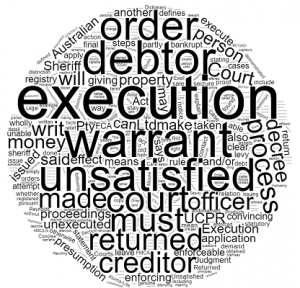Table of Contents
Toggle The presumption of insolvency for unsatisfied execution is another way that a company can be presumed insolvent, or a person commits an act of bankruptcy.
The presumption of insolvency for unsatisfied execution is another way that a company can be presumed insolvent, or a person commits an act of bankruptcy.
The most common way that a creditor can raise the presumption of insolvency against a company is by issuing a creditor’s statutory demand which remaining unsatisfied.
A company is also deemed insolvent (unable to pay its debts) when execution or other process issued on a judgment, is returned unsatisfied in whole or in part.
The most common way that a creditor causes a person to commit an act of bankruptcy is by issuing a bankruptcy notice and the debtor not complying with it.
However, unsatisfied execution is another way that a creditor can make these things happen without having to rely on statutory demands or bankruptcy notices.
This article will explain the process of insolvency for unsatisfied execution.
If a judgment creditor is unable to use a statutory demand or bankruptcy notice, then contact us in relation to founding the presumption of insolvency for unsatisfied execution
OR CALL: 1300 545 133 FOR A FREE PHONE CONSULTATION
Company Winding Up
Section 459C(2)(b) of the Corporations Act 2001 (Cth) is about presumptions to be made in certain proceedings, and says:
(2) The Court must presume that the company is insolvent if, during or after the 3 months ending on the day when the application was made:
(b) execution or other process issued on a judgment, decree or order of an Australian court in favour of a creditor of the company was returned wholly or partly unsatisfied.
So, as a creditor of the company, this raises some questions, namely:
- What is an “execution or other process”?
- What does “issued on a judgment, decree or order of an Australian court” mean?
- What does “returned wholly or partly unsatisfied” mean?
I will explain these in more detail below.
Execution or Other Process Issued on a Judgment
Butterworths Concise Australian Legal Dictionary defines execution as:
The process of enforcing or giving effect to a judgment
This is derived from consideration of the authorities on the term “execution” by Olney J in Re Exell; ex parte Martin (1995) 134 ALR 623 (“Exell”).
In Exell, Olney J said quoting Lord Denning in re Overseas Aviation Engineering (GB) Ltd (1963) Ch 24:
The word “execution” is not defined in the Act. It is, of course, a word familiar to lawyers. “Execution” means, quite simply, the process for enforcing or giving effect to the judgment of the court; and it is “completed” when the judgment creditor gets the money or other thing awarded to him by the judgment. That this is the meaning is seen by reference to that valuable old book Termes de la Ley, where it is said: “Execution is, where judgment is given in any action, that the plaintiff shall recover the land, debt, or damages, as the case is; and when any writ is awarded to put him in possession, or to do any other thing whereby the plaintiff should the better be satisfied his debt or damages, that is called a writ of execution; and when he hath the possession of the land or is paid the debt or damages, or hath the body of the defendant awarded to prison, then he hath execution”. And the same meaning is to be found in Blackman v Fysh (1892) 3 Ch 209, when Kekewich J said that execution means the “process of law for the enforcement of a judgment creditor’s right and in order to give effect to that right”. In cases when execution was had by means of a common law writ, such as fieri facias or elegit, it was legal execution; when it was had by means of an equitable remedy, such as the appointment of a receiver, then it was equitable execution. In either case it was “execution” because it was the process for enforcing or giving effect to the judgment of the court.
In Queensland, the process of enforcing or giving effect to a judgment is by enforcement warrant which will raise the presumption of insolvency for unsatisfied execution.
There are a number of different enforcement warrants or orders that can be made; including:
- Enforcement warrant for redirection of debts.
- Enforcement warrant for seizure and sale of property.
- Enforcement warrant for redirection of earnings.
The execution of a warrant must be compliant with the execution processes and legislation in your State or Territory. For example, the Courts have found that it must be a valid execution.
For example:
- The execution must not be stayed; and/or
- Execution must not have been made without leave on a judgment more than six (6) years old.
Care should be taken that the creditor has the right of immediate execution of the judgment, decree or order. But what is a judgment, decree or order?
Judgment, Decree or Order of an Australian Court
The next requirement is that the execution or other process must be issued on a judgment, decree or order of an Australian court.
What is a Judgment?
In Queensland, “judgment” is defined at rule 659 of the Uniform Civil Procedure Rules 1999 (Qld) and says:
Final relief granted in a proceeding started by claim is granted by giving a judgment setting out the entitlement of a party to payment of money or another form of final relief.
So, a judgment is a grant of final relief given by the Court.
Further, in section 9 of the Corporations Act, judgment is defined as:
“judgment” means a judgment, decree or order, whether final or interlocutory.
Butterworths Concise Australian Legal Dictionary defines judgment as:
The determination of a court in legal proceedings; or any order of the Court for the payment of an amount of money or costs or otherwise; or a judgment also includes a decree or order whether final or otherwise.
So, a judgment is a determination of a court, money order, decree or other order.
What is a Decree?
A decree is essentially the old word for judgment.
Butterworths Concise Australian Legal Dictionary defines decree as:
An order of the court made after due consideration of a case. The term ‘decree’ was originally used to describe the decision in the court of equity, but the term ‘judgment’ is now used to describe the decision of any court.
So, as it relates to civil and commercial disputes, a decree is essentially the same as a judgment.
Section 459C(2)(b) of the Corporations Act also applies to orders or money orders.
What is a Money Order?
Schedule 3 of the UCPR defines an order to include:
a judgment, direction, decision or determination of a court whether final or otherwise
It starts going around in circles, but again it is essentially a determination of the court which is enforceable, such as an enforceable money order.
Rule 793 of the UCPR defines enforceable money order as:
“enforceable money order”, of a court, means—
(a) a money order of the court; or
(b) a money order of another court or tribunal filed or registered under an Act in the court for enforcement.
So, this can include a QCAT decision registered in the correct court.
Ok, so an enforcement creditor has an enforceable judgment, decree or order of an Australian court, and has issued an enforcement warrant for execution.
What does it mean that the execution was returned wholly or partly unsatisfied?
Returned Wholly or Partly Unsatisfied
The execution must be returned wholly or partly unsatisfied. This raises a few more questions:
- Where is execution to be returned to?
- What is wholly or partly unsatisfied?
I will explain these in more detail below.
The Execution is to be Returned
Return means a written statement by the enforcement officer annexed to the execution stating what has been done under it and sent back to the issuing Court registry.
Most State legislation will outline how the unsatisfied execution is to be returned.
In Queensland, rule 822 of the UCPR says:
The registrar or a person who obtains an enforcement warrant for the seizure and sale of property may require the enforcement officer –
(a) to write on the warrant a statement of the steps the enforcement officer has taken under the warrant; and
(b) to send a copy of the statement to the person who obtained the warrant; and
(c) to file a copy of the statement in the registry.
Further, rule 889 of the UCPR says:
(1) The enforcement officer, or another person who is charged with the enforcement of an enforcement warrant, must make a return of the warrant into court if required by the registrar or the person who obtained the issue of the warrant.
(2) The return of an enforcement warrant must be made by filing the original warrant in the registry with a certificate written on or attached to it signed by the enforcement officer, or other person charged with enforcing it, stating what was done to enforce the warrant.
(3) This rule is subject to this chapter.
For the enforcement officer to return the enforcement warrant for seizure and sale of property, the enforcement officer may be required to write on the warrant the steps taken to execute the warrant; with a certificate written on the warrant stating what was done to enforce the warrant; and then file a copy of the statement and the unexecuted warrant in the issuing court registry.
In Guss v Deputy Commissioner of Taxation [2015] FCA 841 Beach J following a long line of precedents said:
[T]he concept of “returned” does not simply embrace being sent back. In form there should be a documentary endorsement or certificate from the sheriff (or associated report) as to what in fact had been done under the warrant and how far the sheriff had been able to carry out his instructions. Further, that warrant and the endorsement (or associated report) are to be returned to the court of issue
Wholly or Partly Unsatisfied
The Courts have found a distinction between “unsatisfied” and “unexecuted”.
In Haridemos, in the matter of ACT Builders Pty Ltd v ACT Builders Pty Ltd [2017] FCA 25 Farrell J made the distinction and said:
I would find that the writ was not returned “unsatisfied” but, rather, the writ was returned “unexecuted”.
This is because:
- The address of the company was empty. Apparently, the judgment debtor moved to other premises and did not change the registered office details with ASIC.
- The Sheriff did not comply with the UCPR in NSW in relation to execution of the writ.
- The judgment debtor did not direct the Sheriff to any other address in New South Wales at which to execute the writ and no further attempt at levy was made by the Sheriff.
Therefore, because the sheriff only attended at the empty ex-premises and made no further attempts to contact the judgment debtor, or go to another premises, the writ was unexecuted.
Farrell J also gave useful references from relevant cases. Her Honour said:
These circumstances are far removed from those in Guss v DCT, in which the extrinsic evidence demonstrated contact by the Sheriff with the debtor who denied having any property which would respond to the writ so that the Court found that the writ had been returned unsatisfied.
They are also removed from the circumstances in Re Ousley, in which the Sheriff’s report referred to an unsuccessful payment demand made by the Sheriff on the debtor, where the Sheriff was refused peaceful entry and was unable to locate “external assets of value (including vehicle)” capable of being seized. The debtor also denied owning a vehicle. The endorsement on the writ was that the bailiffs “were unable to find any real or personal estate upon which to make a levy”, leading to the conclusion that the writ was unsatisfied.
In saying this, I am not importing the requirement which applied under prior enactments of s 40(1)(d)(ii) of the Bankruptcy Act (referred to by Knox CJ in King’s Case at 153) to the effect that the Sheriff has called upon the debtor to satisfy the judgment which the Sheriff is executing and for the debtor to have failed to do so. Rather, these cases indicate the existence of evidence obtained before the writ was returned which established that there were no assets available on which to levy execution.
So, the enforcement officer, bailiff, sheriff, etc must make some genuine attempts to execute the warrant against the property of the enforcement debtor.
In Guss v Deputy Commissioner of Taxation [2015] FCA 841 Beach J said:
[T]he expression “unsatisfied” has to be demonstrated. It must be demonstrated that endeavours have been made to execute the warrant in its terms. There must be a genuine but unsatisfied attempt to levy execution against the debtor and his property.
This would include going to the enforcement debtor’s place of business where company property is kept; and/or calling the enforcement debtor and asking if there property of value capable of being seized; and/or taking any other genuine steps to established that there are no assets available on which to levy execution.
If the creditor manages to prove all the above, then the enforcement debtor company is presumed to be insolvent for a period of three (3) months.
With this presumption of insolvency assisting, the judgment creditor can apply to wind up the judgment debtor company in insolvency.
This is the process against a company, but what principals apply in bankruptcy?
Bankruptcy
Section 40(1)(d)(ii) of the Bankruptcy Act 1966 (Cth) related to acts of bankruptcy and says:
(1) A debtor commits an act of bankruptcy in each of the following cases:
(d) if …
(ii) execution has been issued against him or her under process of a court and has been returned unsatisfied;
So, much the same as with a company debtor, execution must be issued against the enforcement debtor, under a process of the court, and has been returned unsatisfied.
So again, execution is the process of enforcing or giving effect to a judgment. In Queensland, the process of enforcing or giving effect to a judgment is by enforcement warrant.
This would usually be a warrant for seizure and sale of property executed by the enforcement officer (bailiff).
This execution must also be returned unsatisfied. What is the “return” of the warrant in Queensland as it relates to bankruptcy proceedings?
Execution Returned Unsatisfied
Again, in Queensland the return of the execution must be in accordance with rules 822 and 889 of the UCPR.
In Aluma-Lite Products Pty Ltd v Reynolds & Anor [2010] FMCA 122, Burnett FM said:
However as was submitted for the creditor Rule 889(2) does not require service on any particular officer of the Court but merely filing in “the registry” … It follows that for reasons addressed above I am satisfied there has been compliance with Rules 822 and 889 UCPR and that there has been a “return” of the warrant. Execution has been issued against the debtors under process of the Court
Also, as above the warrant must be “unsatisfied” and not simply “unexecuted”.
The enforcement officer, sheriff, bailiff, etc. must have taken some steps to execute the warrant against the property of the enforcement debtor.
Must be Clear and Unambiguous
Because bankruptcy is such an extreme measure against a debtor, the Courts will not usually make an order if there is any ambiguity. In Re Moore (a bankrupt) (1969) 113 S J 791 the following principal was set out:
[p]roof [that] should be clear and convincing; a person should not be made bankrupt on an ambiguity
In Aluma-Lite Products Pty Ltd v Reynolds & Anor [2010] FMCA 122, Burnett FM said:
I am satisfied that an act of bankruptcy has been committed on that date pursuant to section 40(1)(d)(i). In reaching that conclusion I note the submissions of the debtor that bankruptcy requires “proof [that] should be clear and convincing; a person should not be made bankrupt on an ambiguity.”; in Re Moore (a bankrupt). I am satisfied that the facts in this case are indeed clear and convincing and no basis for ambiguity arises.
So, a lot of the same principals apply to both execution on a company and execution on a person in relation to the presumption of insolvency for unsatisfied execution.
Depending on the entity of the judgment debtor, an unsatisfied execution, returned to the registry can form the basis of insolvency proceedings.
It the judgment debtor is a company, then this will be a winding up application.
If the judgment debtor is a human, then this will be a creditor’s petition.
Possible Defences to Insolvency Action
There are a few ways to attempt to defeat this insolvency action. They include:
- The judgment debtor is not insolvent; and/or
- The enforcement of the judgment has been stayed; and/or
- The judgment is not able to be enforced; and/or
- The enforcement officer returned the execution unexecuted and not unsatisfied; and/or
- The proof required is not clear, convincing, and unambiguous.
I will explain these in a little more detail below as they relate to the presumption of insolvency for unsatisfied execution.
The Judgment Debtor is not Insolvent
As in any insolvency action, proof of solvency will typically mean that the Court will not make the order.
There are a lot of factors to consider when making an attempting to rebut the presumption of insolvency.
One of the key cases on this subject of Rebutting the Presumption of Insolvency is Ace Contractors & Staff Pty Ltd v Westgarth Development Pty Ltd [1999] FCA 728 where the Federal Court summarised the relevant authorities.
We have a detailed article here – Rebutting the Presumption of Insolvency
The Enforcement has been Stayed
Another way to attempt to defeat this insolvency action is to apply to the Court for a stay of execution.
In both company insolvency and personal insolvency, the judgment must be able to be executed against the judgment debtor.
If a stay of enforcement can be made pursuant to rule 800 of the UCPR which says:
(1) A court may, on application by an enforcement debtor—
(a) stay the enforcement of all or part of a money order, including because of facts arising or discovered after the order was made; and
(b) make the orders it considers appropriate, including an order for payment by instalments.
(2) The application must be supported by an affidavit stating the facts relied on by the enforcement debtor.
(3) The application and affidavit must be served personally on the enforcement creditor at least 3 business days before the hearing of the application.
If the judgment is not enforceable because of the stay, then the judgment creditor may not attempt execution. This should be given serious consideration when using the presumption of insolvency for unsatisfied execution.
The Judgment is not able to be Enforced
Simply put, if a judgment is not able to be enforced, then the enforcement officer cannot execute the warrant.
For example, if the enforcement officer is attempting to execute a judgment which is more than six (6) years old without leave of the Court pursuant to rule 799 of the UCPR which says:
(2) In addition to another law requiring a court’s leave before an order may be enforced, an enforcement creditor requires a court’s leave to start enforcement proceedings if—
(a) it is more than 6 years since the money order was made; or
(b) there has been a change in an enforcement creditor or enforcement debtor, whether by assignment, death or otherwise.
This issue was discussed in Reasonable Endeavours Pty Ltd v Dennehy [2001] FCA 188 where Marshal J said:
In the present matter, the applicant creditor, at the time of the issuing of the bankruptcy notice, had not taken all steps necessary to entitle it to reap the fruits of its judgment. One of those steps was the application for leave to apply for a warrant of seizure and sale … It follows that the respondent has succeeded on the preliminary issue and ground 5 of the grounds of opposition should be upheld. The creditor’s petition will be dismissed with costs.
So, if the judgment debt is unenforceable, then this may be an argument to dismiss the insolvency proceedings.
The Enforcement Officer Returned the Execution Unexecuted and not Unsatisfied
As stated above, the Courts have made a distinction between “unexecuted” and “unsatisfied”.
If a judgment debtor can make an argument that the execution was returned unexecuted rather than unsatisfied, then this may be a good argument to dismiss the insolvency proceedings.
Care should be taken when instructing the enforcement officer if using the presumption of insolvency for unsatisfied execution.
The Proof Required is not Clear, Convincing, and Unambiguous
As per Re Moore (a bankrupt) (1969) 113 S J 791 and Aluma-Lite Products Pty Ltd v Reynolds & Anor [2010] FMCA 122, the proof required to make the order making the judgment debtor insolvent must be clear, convincing, and unambiguous.
If the court documents, pleadings, affidavits are not certain, clear, convincing, and unambiguous, then this may be a good argument to dismiss the insolvency proceedings.
Care should be taken when drafting all court documents if using the presumption of insolvency for unsatisfied execution.
Presumption of Insolvency for Unsatisfied Execution FAQ
We get asked questions in relation to the presumption of insolvency for unsatisfied execution. We will answer the most frequently asked questions below.
What is the presumption of insolvency?
Section 459C(2)(b) of the Corporations Act 2001 (Cth) is about presumptions to be made in certain proceedings, and says … (2) The Court must presume that the company is insolvent if, during or after the 3 months ending on the day when the application was made … (b) execution or other process issued on a judgment, decree or order of an Australian court in favour of a creditor of the company was returned wholly or partly unsatisfied.
What is an act of bankruptcy?
Section 40(1)(d)(ii) of the Bankruptcy Act 1966 (Cth) related to acts of bankruptcy and says … (1) A debtor commits an act of bankruptcy in each of the following cases … (d) if … (ii) execution has been issued against him or her under process of a court and has been returned unsatisfied;
What is an “execution” of enforcement?
“Execution” means, quite simply, the process for enforcing or giving effect to the judgment of the court; and it is “completed” when the judgment creditor gets the money or other thing awarded to him by the judgment.
What does execution “returned” mean?
Return means a written statement by the enforcement officer annexed to the execution stating what has been done under it and sent back to the issuing Court registry. In Queensland, rule 822 of the UCPR says: The registrar or a person who obtains an enforcement warrant for the seizure and sale of property may require the enforcement officer – (a) to write on the warrant a statement of the steps the enforcement officer has taken under the warrant; and (b) to send a copy of the statement to the person who obtained the warrant; and (c) to file a copy of the statement in the registry.
What does “wholly or partly unsatisfied” mean?
The Courts have found a distinction between “unsatisfied” and “unexecuted”. The enforcement officer, bailiff, sheriff, etc must make some genuine attempts to execute the warrant against the property of the enforcement debtor. The expression “unsatisfied” has to be demonstrated to show that endeavours have been made to execute the warrant in its terms. There must be a genuine but unsatisfied attempt to levy execution against the debtor and the debtor’s property.
If a judgment creditor is unable to use a statutory demand or bankruptcy notice, then contact us in relation to founding the presumption of insolvency for unsatisfied execution
OR CALL: 1300 545 133 FOR A FREE PHONE CONSULTATION








